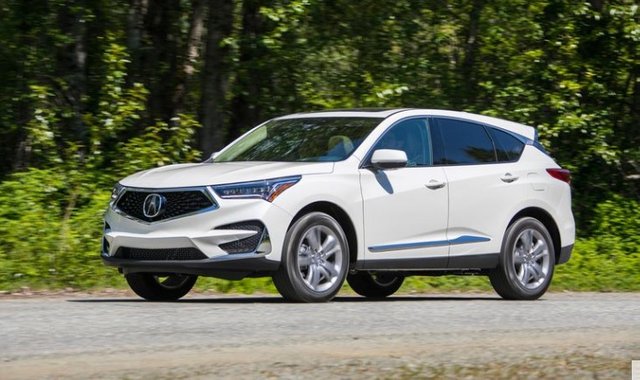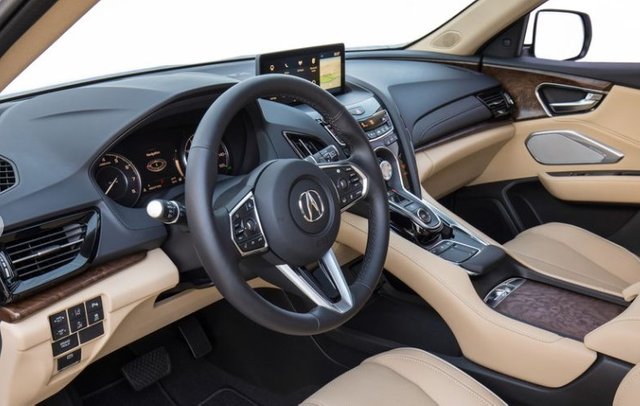2019 Acura RDX New Design Upcoming
For all the advances realized by the completely new 2019 Acura RDX, the automaker’s agenda to remake it from a popular but dynamically unremarkable vehicle into a genuinely sporting one can be distilled down to one ostensibly minor and optimistic detail: The default setting for the RDX’s Integrated Dynamics driving-mode system is Sport. (Those so inclined can dive deep into the submenus and change the default mode to Comfort.) Realized with a simple software tweak—or a relabeling of the switch, for the cynics among us—the decision to proactively bias the luxury compact crossover’s personality carries significant weight. Signaling not only a tangible attitude adjustment from that of the previous RDX, which defaulted to Comfort mode, this also plays into Acura’s attempted spiritual reawakening initiated with the return of the NSX.
The first RDX to be entirely designed and constructed in the United States, the third-generation 2019 model is larger than the outgoing car in nearly every respect. The wheelbase grows to 108.3 inches from 105.7, the overall length expands to 186.8 inches from 184.4, and height is up slightly to 65.7 inches from 65.0. The engine, on the other hand, shrinks in both displacement and cylinder count, with the previous RDX’s naturally aspirated 3.5-liter V-6 having been replaced with a smaller but torquier turbocharged 2.0-liter inline-four. The turbo four’s 272 horsepower clocks in just seven ponies shy of the outgoing V-6’s 279, but the new engine tromps the old one in the torque department at 280 lb-ft to 252. Gear swaps are handled by a version of the corporate 10-speed automatic transmission that has been popping up across the Honda and Acura universe since it first appeared in the 2018 Odyssey, bringing with it the now familiar buttons for gear selection. The RDX is available in both front- and all-wheel-drive configurations; the latter employs Acura’s Super Handling All-Wheel Drive (SH-AWD) for a cool $2000 upcharge regardless of trim level.

New Feature Concept
The compact-luxury-crossover segment is no place for the faint of features, and the new RDX certainly panders to the compulsions of modern tech- and luxury-obsessed buyers. Standard highlights include a panoramic sunroof, an acoustically insulated windshield, heated mirrors, heated 12-way power-adjustable front seats, LED head- and taillights, push-button start, two USB charging ports in front, adaptive cruise control, a multiview backup camera, and the AcuraWatch package of safety and assistance features including forward-collision warning, automated emergency braking, lane- and road-departure warning systems, and lane-keeping assist. It’s a rich set of features, excepting a few peculiarities: Curiously, no inductive device charging is available, and Apple CarPlay is standard, but Google is still working to make Android Auto compatible with the new Acura True Touchpad interface—more on that in a moment.
Additional features are generally bundled within the four available trim packages. The base RDX includes everything above and more. The Technology trim adds navigation, a 12-speaker audio system, two rear-seat USB ports, leather-trimmed sport seats, parking sensors, blind-spot monitoring, and rear cross-traffic alert. The RDX A-Spec builds on that with specific 20-inch wheels, A-Spec badging, and different exterior styling. A-Spec trims also get model-specific heated and ventilated leather front sport seats, dark aluminum trim, a different steering wheel, and a premium 16-speaker audio system. The top-level Advance trim brings a 10.5-inch head-up display, adaptive dampers, a heated steering wheel, heated rear seats, a hands-free power liftgate, acoustically insulated side glass, genuine wood interior trim, leather upholstery, and 16-way power front seats with adjustability for lumbar, side bolsters, and thigh extensions. You’ll find more feature minutiae buried in the online configurator (click here for our story about RDX pricing).

See What the New Design
Dubbed True Touchpad Interface, Acura’s answer to the perceived infotainment dilemma uses a high-mounted 10.2-inch screen controlled by a console-mounted touchpad positioned just ahead of the armrest. The idea is that while touchscreens are intuitive, their mounting position is compromised by the conflicting needs to be both accessible and easily viewed. While similar in concept to Lexus’s Remote Touch setup, Acura’s True Touchpad Interface has no cursor, instead relying on the user’s procedural memory to tap the area of the touchpad that directly relates to the same area on the display. If you want to select the Bluetooth app at the top right of the display, for instance, you simply tap the top-right area of the touchpad. No sliding or dragging of your finger or a joystick is required, and you don’t need to take your eyes off the road to finesse a cursor into place. When you hit your mark, the selection is highlighted on the display. A pair of hard buttons provide back and home functions, and a smaller “B-zone” located directly to the right provides touchpad operation of a secondary function such as music selection, which is displayed on the right side of the screen. After a short familiarization period, we were hitting our desired marks with something like an 85 percent success rate, and the system carried out our commands without lag or misdirection. Acura wisely went with hard buttons for the HVAC controls, however, as that display is not touch-capable, bucking the current trend of providing redundancy by combining a touchscreen with a control pad or hard buttons. Overall, this is a noble effort with intuitive functionality, although we didn’t find it to be the game-changing solution that the world’s automakers apparently seek.
Thankfully, the 2019 RDX is more than a rolling display case for the latest digital realizations. The Acura-specific chassis is new from the ground up, more than half of it built of high-strength steel and, in a first for Acura, using plenty of high-performance structural adhesives. Inner and outer hot-stamped front-door rings increase body rigidity, while the rear frame substructure was specifically designed to distribute suspension loads over a wider area. The downside? A cross beam about the size of a two-by-four runs directly across the floor of the cargo area. To mitigate the intrusion, Acura designed a nifty storage-bin insert with segmented cubbies, then hid the whole shebang under a flat floor panel. Acura says cargo capacity behind the rear seat has increased from 26 cubic feet in the old RDX to 30 in the new one. There’s no shortage of real estate for the driver and front passenger, and rear-seat passengers have plenty of elbow and knee room, although rear headroom is still tight—largely thanks to the panoramic sunroof (reminder: it’s standard).
The New Normal Thinks
Three additional driving modes supplement the personality-defining Sport: Snow, Comfort, and Sport+. Leaving it in the default Sport setting reveals a well-balanced ride with minimal body lean, but requests for urgent acceleration from typical secondary-road speeds linger unheeded for a heartbeat or three while the transmission performs its cog-skipping 10-6-4 downshift trick to put the engine in the meat of its 1600-to-4500-rpm max-torque band. Depress the round S button behind the transmission switchgear for more expedient shifts executed automatically or via the standard shift paddles. As you might expect, selecting Sport+ mode heightens nearly every parameter including steering and throttle response, as well as the digitally enhanced engine soundtrack and—if you spring for the top-line Advance trim—the adaptive dampers. The engine itself is a willing unit that combines proven VTEC technology with a low-inertia turbo to create a broad torque plateau unmatched by the outgoing naturally aspirated V-6.
While the variable-ratio electrically assisted power steering provides direct and linear response in all modes, the RDX carries an ace up its sleeve in the form of the latest version of Acura’s Super Handling All-Wheel Drive, which is probably why all the vehicles Acura made available for our first drive were so equipped. Capable of sending 70 percent of available torque to the rear wheels, SH-AWD’s real trick is its ability to route 100 percent of that torque to the left or right wheel to create a yaw moment, coaxing the RDX to turn more sharply than it would otherwise be capable. This in turn alleviates much of the plow often associated with vehicles that carry most of their mass on the front wheels. Despite its claimed 57/43 front/rear weight distribution, the RDX with SH-AWD maintains a tight line when pushed. A confidence-inspiring trait, it makes quick work out of erasing mildly banked 90 degree turns. The feel at the wheel is light and lively, and the RDX as a whole feels lighter on its feet than a comparably equipped BMW X3 but can’t match the Bavarian in terms of solidity and precision. The stoic Audi Q5, by comparison, feels almost reluctant when pressed to perform similar tight maneuvers, leading us to wonder just how much work its rear wheels are doing. Leaning heavily on the software to extract the RDX’s agility, however, leads to a slightly synthetic overall feel, and steering feedback is but a myth, although the effort does build progressively. The 255/45R-20 Goodyear Eagle RS-A tires on our A-Spec tester (other trims wear 235/55R-19 rubber) gave plenty of audible warning before the front end started to give up and push wide. This is one AWD vehicle that will actually step its tail out given the proper circumstances—say, a gravel parking lot with the traction control defeated—but you didn’t hear that from us.

Despite its reputation as an unexciting car, the previous RDX continued to post top sales numbers in the luxury-compact-crossover segment that it essentially invented. With the 2019 model, Acura has taken some calculated risks to recast the RDX with the excellent dynamic qualities of the first-gen model while trying to retain the sales success of the blander second generation. With a base price of just $38,295 for a front-wheel-drive base model and $48,395 for a top-trim Advance SH-AWD model, it offers well-equipped packages at prices where some of its European competitors begin. As a brand built on offering affordable indulgence, Acura knows that value can sometimes be the most appealing performance attribute of all.
Hi! I am a robot. I just upvoted you! I found similar content that readers might be interested in:
https://www.caranddriver.com/acura/rdx
Welcome to Steem, @michealwill!
I am a bot coded by the SteemPlus team to help you make the best of your experience on the Steem Blockchain!
SteemPlus is a Chrome, Opera and Firefox extension that adds tons of features on Steemit.
It helps you see the real value of your account, who mentionned you, the value of the votes received, a filtered and sorted feed and much more! All of this in a fast and secure way.
To see why 2835 Steemians use SteemPlus, install our extension, read the documentation or the latest release : SteemPlus 2.17.4 : Two new features on Busy and bug fixes.
Hello @michealwill!
I noticed you have posted many times since you began your journey on Steemit. That is great! We love active partipants.
I do want to point out that the Introduceyourself tag is meant to be used once only to introduce yourself to the Steemit community. You have now posted 6 times using the introduceyourself tag. Please see this link for more information on Tag Spam?
Please take this into consideration and help build a great platform!